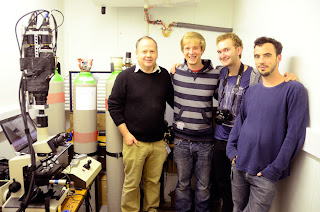
Welcome to Pembrokeshire Wildlife, a blog for general wildlife sightings, discussion, comments, questions and observations. Email andy@andydavies.info if you would like to make posts. Anyone can add a comment to an existing post.
Emporer moth

By Peter Byles
Monday, 20 June 2011
Filming Dinoflagellates at the National Oceanography Centre at Southampton was an interesting challenge. The objective was to show the bioluminescence produced when algal cells are stimulated chemically or by physical shock, but also simulating how it would look for real in the open ocean! A cunning beamsplitter prototype camera supplied by Ammonite ltd that is sensitive to to infra red and blue light was coupled to my microscope system, this enables the cells which in nature only bioluminesce at night, to be imaged using infra red while the very highly sensitivite blue camera captures the bioluminescence. The blue camera has an effective sensitivity of 18,000,000 ISO, which is remarkable compared to an average DSLR which has a maximum sensitivity of 25,600 ISO. Different species of Dinoflagellates were observed to bioluminesce, some more brightly than others. Martha Valiadi and Charlotte Marcinko, phD Students from Ocean Biochemistry and Ecosystems assisted us with the supply of fresh cultures and their preparation for filming. We looked at various species of Dinoflagellates including Pyrocystis fusiformis, Pyrocystis lunula, Pyrocystis noctiluca and Alexandrium tamarense.

Subscribe to:
Post Comments (Atom)


I enjoyed reading this interesting scientific article. A million thanks for sharing.
ReplyDeleteWarmest greetings from Spain.